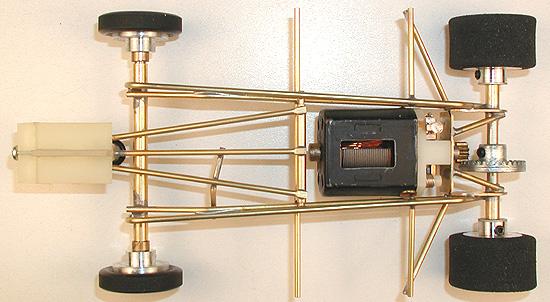Russkit Factory Team Builds to Win
A replica early 1966 chassis by Steve Okeefe
The subject of the April 1966 Car Model "Russkit Factory Team Builds to Win" article is an ingenious, although primitive, semi space-frame chassis that seems to serve as a showcase for Russkit products as much as anything else.
Nevertheless, the design and construction of this chassis provides a clear insight into the early days of scratchbuilding in the classic era.
Above: Top view. Built to specs given in the article. All the chassis parts are brass, and with the exception of the motor bracket, it's all tubing. The purpose of using tubing was to reduce weight, even though tubing was known to be a considerably weaker building material than rod. Pin tube body mount design is clearly in its early stages of development!
Above: Bottom view. Those three brass tubes that make up the drop arm are crimped flat at the point where they are soldered to the drop arm hinge. Primitive, but it works. The tapered main rails are in reality not a performance inspired design feature so much as a simple necessity in order to clear the motor! In this case, the tapered design does not add to the weight, but it does make the chassis more complicated to build without adding appreciably to the performance.
Above: Rear axle. That's a genuine Russkit Spyder crown gear, made out of genuine pot metal. The four large lightening holes in the gear web demonstrate that some thought was given to keeping the weight down, but the shape of the gear teeth, and the rough gear mesh they make, leaves something to be desired! Lack of a bracket brace around the gear is evidence of the belief that there should be NO weight aft of the rear axle, even at the expense of a weaker bracket design and failure to protect the gear!
Above: Front end. A genuine Russkit Slant Guide, with a genuine miniature O-ring retaining it. I never had much faith in the claim that the angled pivot post improved the ability of the car to stick in the slot, nor did I believe that the little O-ring was actually going to hold the guide in place! Again, an ingenious early design that unfortunately did not stand up to the harsh realities of competitive racing. On the other hand, Russkit WAS out there, trying new ideas, some of which are still going strong today!



















